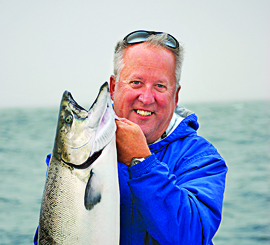I was stretched out in bed the other morning around 5 a.m. when I started to write this column in my mind. While October is here, and there is plenty to consider during this month of seasonal change from summer to fall, I’ve decided to dive into a pending changing of the guard at the top position within the Washington Department of Fish & Wildlife.
As most longtime readers of this column have learned, I’ve spent nearly half of my life investing those years into the machinery of this agency. During those 30 years, I worked for nine directors of the department, which earned me some perspective of the challenges and responsibilities of the job.
That job will be available soon, as current Director Phil Anderson recently announced he would no longer occupy the top position at the agency and will move on with life, effective the end of this year, after seven years at the helm.
Hey! The good news is that the job could be yours at a cool $140,000 a year, with a gorgeous big office overlooking Budd Inlet in Olympia on the 5th floor of the Natural Resource Building. Sound wonderful? Wrong!
While the job carries a certain amount of prestige, it is thankless and controversial. Every decision the director makes brings a silent nod of approval from those who benefit from the decision, but more importantly, triggers a tsunami of manure from those who do not.
As Anderson might suggest after his tenure in the hot seat, going to work to get whacked day after day takes its toll. And that toll is a fundamental reason why Phil Anderson has declared enough is enough. I don’t blame him.
Think about it. The director of Fish and Wildlife serves at the pleasure of the Fish and Wildlife Commission, which sets policy for the agency. Meetings after meetings, the director is on stage, defending or promoting his or her direction, nonstop. Now apply the responsibility to manage every swinging species of fish and wildlife in our state for conservation, or in many cases, allocation purposes. And while the task of managing for conservation has its own challenges, so does the allocation of harvestable species among user groups who bring their opinions to the director’s doorstep. Sound like fun? Pass the Rolaids, please.
Some of these opinions by users go directly to their legislators, who in turn whack the director. And if those phone calls don’t get his attention, too often, the agency’s budget is held hostage in the political process. More fun, huh?
In my view, Phil Anderson is superhuman. He is on the road every morning around 5 am with Westport in the rearview mirror, headed for Olympia, on a normal day. While he is the skipper of a 1,500-employee agency, he serves on more boards, committees and councils than Barack Obama.Module Art Panels
For example, he travels the state, attending meetings governing the management of wolves, bear, elk, deer and every species of fish and shellfish imaginable. And if all the users of these critters are happy, such as the coastal razor clam fishery, there is very little demand on his schedule.
I’ve known Phil Anderson for nearly 40 years, when I first listened to him testify before the Legislature, representing the coastal charter boat fishing community in Westport. He was deliberate, smart, calculating and knowledgeable about the resources he manages. He is the same person today, times nine million.
I’ve also had the privilege to fish next to Phil on his beloved Monte Carlo, a 50-foot Delta in showroom condition. Not only can Phil fish, he puts the net on a fish faster that you can say, “Net it now, Phil.” Boom, in the net and on the deck before you can say, “Holy macaroni, skipper!”
Anderson chooses to leave the department on his own terms. Most directors leave with their head in their hands, or lodged in some other uncomfortable place. But he has had enough and will head for more friendly grounds in Westport, the Gibraltar of his life. I wish Phil the best and respect his time and leadership steering the Fish and Wildlife ship. He is a good man.
Fall Fishing Opportunities
As the leaves of spring and summer turn and begin to fall, I like the fishing options for October. First, it’s time to go razor clam digging on the Washington coast. For readers who have not dug razor clams, you are missing tons of fun and super good eats. Do you like calamari? If the answer is yes, you’ll love razor clams.
October also triggers the reopening of many areas for Dungeness crab. Check in with the department’s website for your areas of interest as again, many areas will reopen but some will not.
Finally, I like the hat trick up in north Puget Sound around Point No Point as taught by my mentor, Frank Haw. Late-arriving coho salmon are mixed with prime time for saltwater migrating chum salmon and the new crop of immature chinook salmon (blackmouth). These blackmouth represent next year’s king salmon population, as they provide the first snapshot of the strength or weakness of those hatchery-produced stocks.
I’m staying outdoors in Octobers as there’s plenty to do. See you on the water.